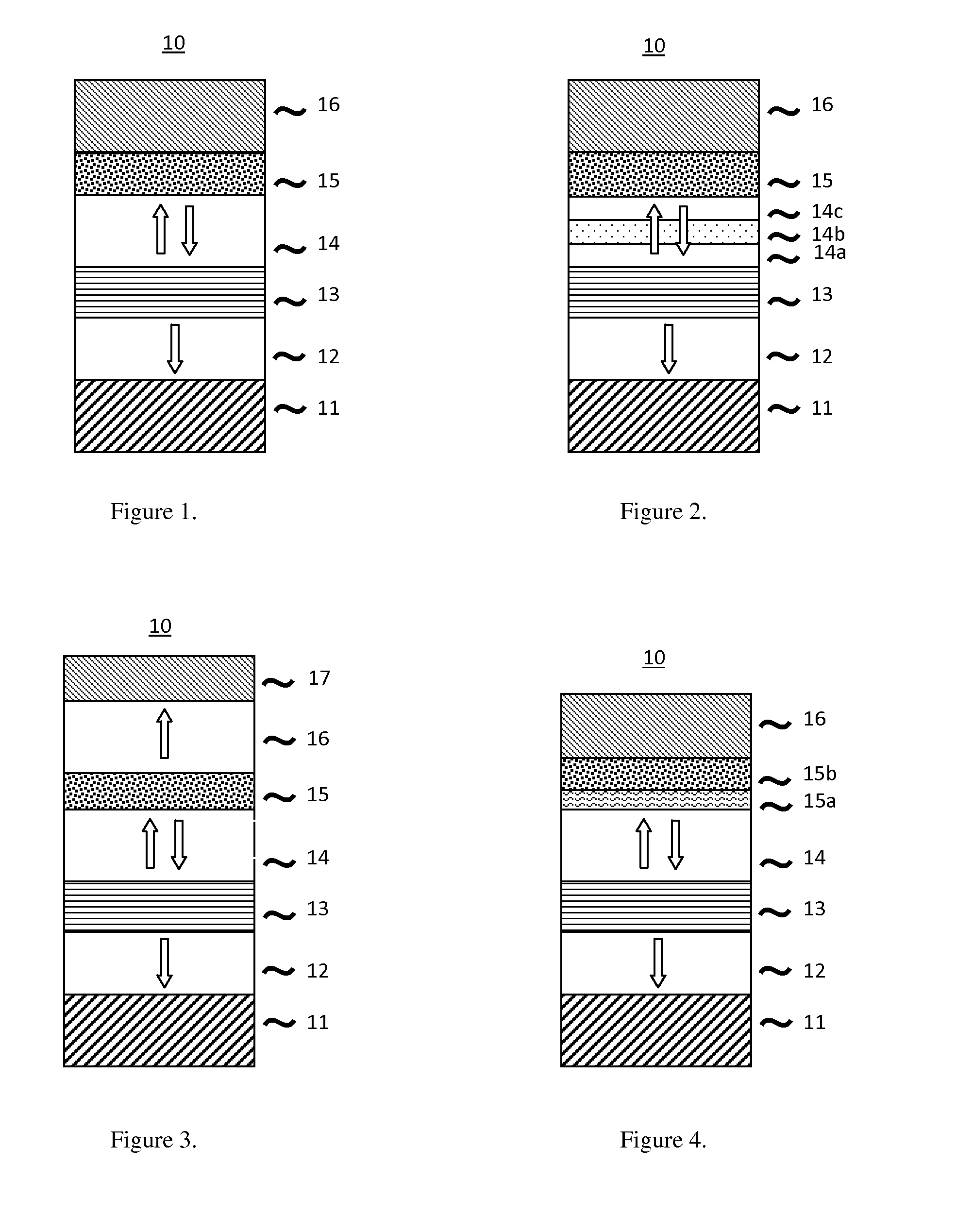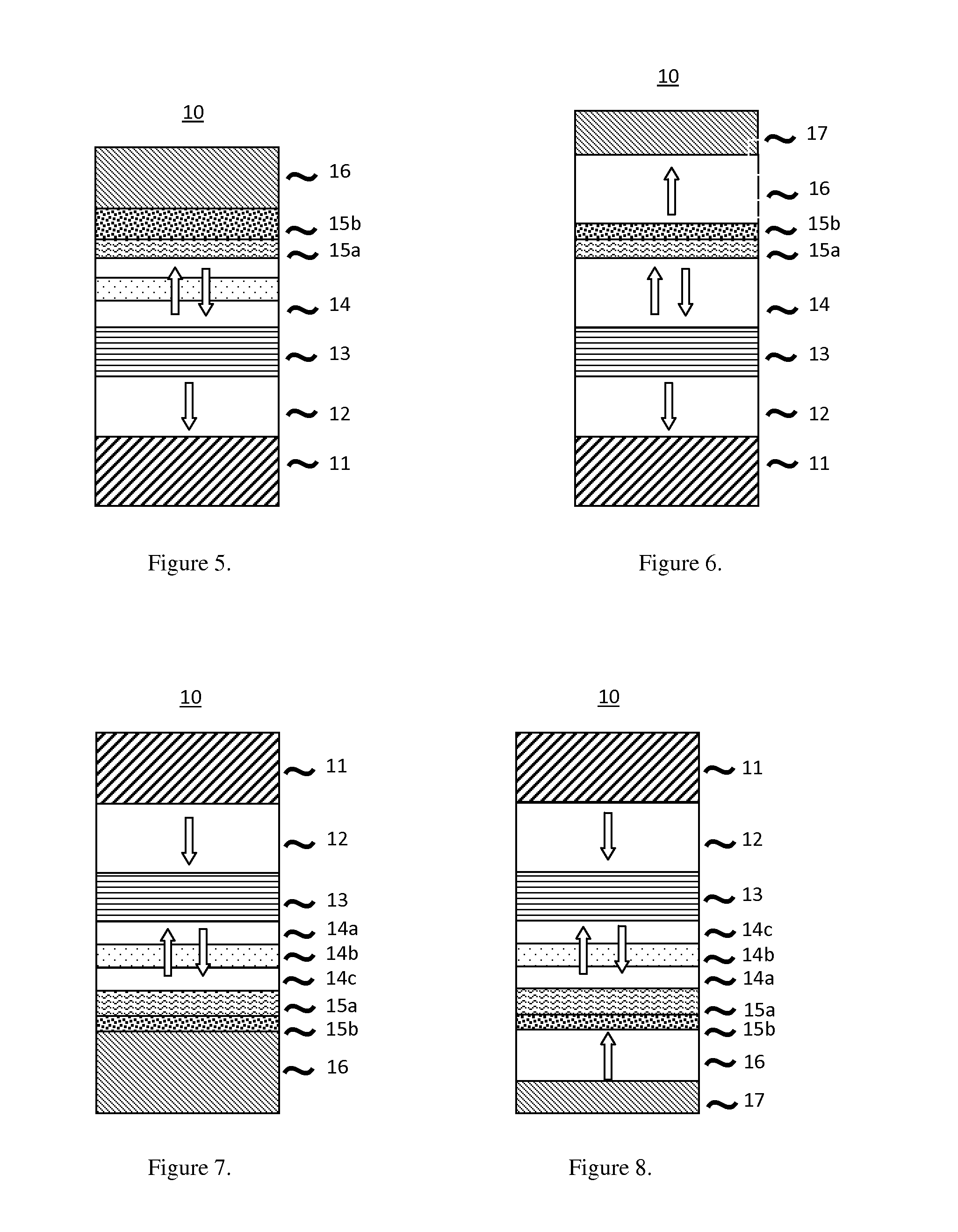Novel perpendicular magnetoresistive elements
a technology of perpendicular magnetization and magnetic crystalline anisotropy, which is applied in the direction of digital storage, semiconductor devices, instruments, etc., can solve the problems of difficult reduction of write current, insufficient magnetic crystalline anisotropy to achieve thermally stable perpendicular magnetization, etc., and achieve the effect of electrical conductivity enhancemen
- Summary
- Abstract
- Description
- Claims
- Application Information
AI Technical Summary
Benefits of technology
Problems solved by technology
Method used
Image
Examples
first embodiment
[0027]FIG. 1 is a cross-sectional view showing a configuration of an MTJ element 10 as a MTJ element according to the first embodiment. The MTJ element 10 is configured by stacking a seed layer as a bottom electrode 11, a reference layer 12, a tunnel barrier layer 13, a recording layer 14, a buffer layer 15, and a base layer 16 in this order from the bottom.
[0028]The recording layer 14 and reference layer 12 each are made of a ferromagnetic material, and have uni-axial magnetic anisotropy in a direction perpendicular to a film surfaces. Further, directions of easy magnetization of the recording layer 14 and reference layer 12 are also perpendicular to the film surfaces. In another word, the MTJ element 10 is a perpendicular MTJ element in which magnetization directions of the recording layer 14 and reference layer 12 face in directions perpendicular to the film surfaces. A direction of easy magnetization is a direction in which the internal magnetic energy is at its minimum where no...
second embodiment
[0038]FIG. 4 is a cross-sectional view showing an example configuration of the MTJ element 10 according to the second embodiment. The MTJ element 10 is configured by stacking a seed layer as a bottom electrode 11, a reference layer 12, a tunnel barrier layer 13, a recording layer 14, a first buffer layer 15a, a second buffer layer 15b, and a base layer 16 in this order from the bottom.
[0039]A single buffer layer, as shown in FIG. 1, is made of MgXO where X is a doping element selected from Cr, Al, B, Si, etc. As the thermal annealing with a temperature higher than 250-degree is conducted for the crystallization of CoFeB recording layer, some dopants may have a strong tendency to accumulate in a near surface region, the original rocksalt crystal structure of MgO may deteriorate in the interface region close to the recording layer, accordingly the perpendicular anisotropy strength may be degraded.
[0040]In this embodiment, the buffer layer 15 has a bi-layer structure in which a first b...
third embodiment
[0043]FIG. 7 is a cross-sectional view showing an example configuration of the MTJ element 10 according to the third embodiment. This is a reversed structure of the first modification of the second embodiment as shown in FIG. 5.
[0044]FIG. 8 is a cross-sectional view showing an example configuration of the MTJ element 10 according to a first modification of the third embodiment. This is a reversed structure of the second modification of the second embodiment as shown in FIG. 6, except that the recording layer 14 has a multi-layer structure in which a first ferromagnetic layer 14a, a nonmagnetic insertion layer 14b, and a second ferromagnetic layer 14c.
PUM
| Property | Measurement | Unit |
|---|---|---|
| thickness | aaaaa | aaaaa |
| lattice mismatch | aaaaa | aaaaa |
| magnetoresistive | aaaaa | aaaaa |
Abstract
Description
Claims
Application Information
 Login to View More
Login to View More - R&D
- Intellectual Property
- Life Sciences
- Materials
- Tech Scout
- Unparalleled Data Quality
- Higher Quality Content
- 60% Fewer Hallucinations
Browse by: Latest US Patents, China's latest patents, Technical Efficacy Thesaurus, Application Domain, Technology Topic, Popular Technical Reports.
© 2025 PatSnap. All rights reserved.Legal|Privacy policy|Modern Slavery Act Transparency Statement|Sitemap|About US| Contact US: help@patsnap.com



